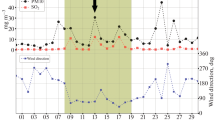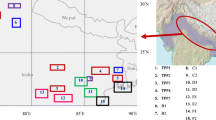Abstract
Sulphur dioxide is a toxic pollutant in the atmosphere emitted from natural sources and human activities. Normally, SO2 has a life-time of about 2 days in the atmosphere and is not transported to long distances from its source region. However, under favourable circumstances such as low humidity or high wind speed, it can travel intercontinental distances from the point of emission. In this article, we have analysed the surface mixing-ratio of SO2 measured over the time period from January 2010 to April 2012 at a rural region in south India. It is found that SO2 mixing-ratio is very low over this region with an annual mean value in the range of 0.21–0.24 ppbv. OMI satellite estimates an annual mean value of 0.5 Dobson Units (DU) over the same location and period. However, during January to May relatively higher concentrations of SO2 are observed, mainly coming from power plants located in southern and eastern India as indicated by higher SO2/NO2 ratios of greater than 0.5. In one instance, on June 20th, 2011, it is found that the OMI SO2 value was a factor of 13 higher than 2011 annual mean at Gadanki. Using the FLEXible PARTicle dispersion model (FLEXPART) and satellite data, it is found that the observed higher SO2 value on 20th June was due to intercontinental transport of SO2 from Nabro volcanic eruption. Using the FLEXPART model with ECLIPSE-v5 emission inventory, the observed seasonal variation of SO2 could be well reproduced; however, the mixing ratios are found to be overestimated. CAMS (Copernicus Atmosphere Monitoring Service) SO2 reanalysis values available through its implementation in the ECMWF Integrated Forecasting System are a factor of 7.8 higher than observations, possibly due to incorrect vertical profile used in the model.











Similar content being viewed by others
References
Amann M, Bertok I, Borken-Kleefeld J, Cofala J, Heyes C, Höglund-Isaksson L, Klimont Z, Nguyen B, Posch M, Rafaj P, Sandler R, Schöpp W, Wagner F and Winiwarter W 2011 Cost-effective control of air quality and greenhouse gases in Europe: Modeling and policy applications; Environ. Model. Softw. 26 1489–1501.
Aneja V P, Agarwal A, Roelle P A, Phillips S B, Tong Q, Watkins N and Yablonsky R 2001 Measurements and analysis of criteria pollutants in New Delhi, India; Environ. Intern. 27 35–42.
Babu S S, Moorthy K K, Manchanda R K, Sinha P R, Satheesh S K, Vajja D P, Srinivasan S and Kumar V H A 2011 Free tropospheric black carbon aerosol measurements using high altitude balloon: Do BC layers build and their own homes up in the atmosphere?; Geophys. Res. Lett. 38 L08803+.
Berglen T F, Berntsen T K, Isaksen I S A and Sundet J K 2004 A global model of the coupled sulfur/oxidant chemistry in the troposphere: The sulfur cycle; J. Geophys. Res. 109 D19310.
Bey I, Jacob D J, Yantosca R M, Logan J A, Field B D, Fiore A M, Li Q, Liu H Y, Mickley L J and Schultz M G 2001 Global modeling of tropospheric chemistry with assimilated meteorology: Model description and evaluation; J. Geophys. Res. 106 23073+.
Charlson R J, Langer J and Rodhe H 1990 Sulphate aerosol and climate; Nature 326 655–661.
Charlson R J, Langner J, Rodhe H, Leovy C B and Warren S G 1991 Perturbation of the northern hemisphere radiative balance by backscattering from anthropogenic sulfate aerosols; Tellus A 43 152–163.
CPCB 2009 National Air Quality Standards; Central Pollution Control Board (CPCB).
Fiedler V, Nau R, Ludmann S, Arnold F, Schlager H and Stohl A 2009 East Asian SO2 pollution plume over Europe – Part 1: Airborne trace gas measurements and source identification by particle dispersion model simulations; Atmos. Chem. Phys. 9 4717–4728.
Finlayson-Pitts B J and Pitts J N 2000 Chemistry of the Upper and Lower Atmosphere Theory, Experiments, and Applications; Academic Press, San Diego.
Flemming J, Benedetti A, Inness A, Engelen R J, Jones L, Huijnen V, Remy S, Parrington M, Suttie M, Bozzo A, Peuch V-H, Akritidis D and Katragkou E 2017 The CAMS interim reanalysis of Carbon Monoxide, Ozone and Aerosol for 2003–2015; Atmos. Chem. Phys. 17 1945–1983.
Flemming J, Huijnen V, Arteta J, Bechtold P, Beljaars A, Blechschmidt A M, Diamantakis M, Engelen R J, Gaudel A, Inness A, Jones L, Josse B, Katragkou E, Marecal V, Peuch V H, Richter A, Schultz M G, Stein O and Tsikerdekis A 2015 Tropospheric chemistry in the integrated forecasting system of ECMWF; Geosci. Model. Develop. 8 975–1003.
Gadhavi H and Jayaraman A 2006 Airborne lidar study of the vertical distribution of aerosols over Hyderabad, an urban site in central India, and its implication for radiative forcing calculations; Annal. Geophys. 24 2461–2470.
Gadhavi H S, Renuka K, Kiran V R, Jayaraman A, Stohl A, Klimont Z and Beig G 2015 Evaluation of black carbon emission inventories using a Lagrangian dispersion model – a case study over southern India; Atmos. Chem. Phys. 15 1447–1461.
Gadi R, Kulshrestha U C, Sarkar A K, Garg S C and Parashar D C 2003 Emissions of SO2 and NOx from biofuels in India; Tellus B 55 787–795.
Garg A, Kapshe M, Shukla P R and Ghosh D 2002 Large point source (LPS) emissions from India: Regional and sectoral analysis; Atmos. Environ. 36 213–224.
Hennermann K and Guillory A 2018 CAMS reanalysis data documentation; https://confluence.ecmwf.int/display/CKB/CAMS+Reanalysis+data+documentation.
Kandlikar M 2007 Air pollution at a hotspot location in Delhi: Detecting trends, seasonal cycles and oscillations; Atmos. Environ. 41 5934–5947.
Kiehl J T and Briegleb B P 1993 The relative roles of sulfate aerosols and greenhouse gases in climate forcing; Science 260 311–314.
Klimont Z, Kupiainen K, Heyes C, Cofala J, Rafaj P, Höglund-Isaksson L, Borken J, Schöpp W, Winiwarter W, Purohit P, Bertok I and Sander R 2013 ECLIPSE V4a: Global emission data set developed with the GAINS model for the period 2005 to 2050: Key features and principal data sources.
Klimont Z, Kupiainen K, Heyes C, Purohit P, Cofala J, Rafaj P, Borken-Kleefeld J and Schöpp W 2017 Global anthropogenic emissions of particulate matter including black carbon; Atmos. Chem. Phys. 17 8681–8723.
Krotkov N A, McLinden C A, Li C, Lamsal L N, Celarier E A, Marchenko S V, Swartz W H, Bucsela E J, Joiner J, Duncan B N, Boersma K F, Veefkind J P, Levelt P F, Fioletov V E, Dickerson R R, He H, Lu Z and Streets D G 2016 Aura OMI observations of regional SO2 and NO2 pollution changes from 2005 to 2015; Atmos. Chem. Phys. 16 4605–4629.
Krotkov N A, Li C and Leonard P 2015 OMI/Aura Sulfur Dioxide (SO2) Total Column L3 1 day Best Pixel in 0.25° × 0.25° V3, Greenbelt, MD, USA, Goddard Earth Sciences Data and Information Services Center (GES DISC), https://doi.org/10.5067/Aura/OMI/DATA3008.
Li C, Krotkov N A, Carn S, Zhang Y, Spurr R J D and Jointer J 2017 New-generation NASA Aura Ozone Monitoring Instrument (OMI) volcanic SO2 dataset: Algorithm description, initial results, and continuation with the Suomi-NPP Ozone Mapping and Profiler Suite (OMPS); Atmos. Measurement Tech. 10 445–458.
Lu Z, Streets D G, de Foy B and Krotkov N A 2013 Ozone monitoring instrument observations of interannual increases in SO2 emissions from indian coal-fired power plants during 2005–2012; Environ. Sci. Technol. 47 13,993–14,000.
Mallik C, Parth Sarathi M, Kumar P, Panda S, Boopathy R, Das T and Lal S 2019 Influence of regional emissions on SO2 concentrations over Bhubaneswar, a capital city in eastern India downwind of the Indian SO2 hotspots; Atmos. Environ. 209 220–232.
Mallik C and Lal S 2014 Seasonal characteristics of SO2, NO2, and CO emissions in and around the Indo-Gangetic Plain; Environ. Monit. Assess.186 1295–1310.
Mallik C, Venkataramani S and Lal S 2012 Study of a high SO2 event observed over an urban site in western India; Asia-Pac. J. Atmos. Sci. 48 171–180.
Naja M, Mallik C, Sarangi T, Sheel V and Lal S 2014 SO2 measurements at a high altitude site in the central Himalayas: Role of regional transport; Atmos. Environ. 99 392–402.
Reddy R R, Rama Gopal K, Narasimhulu K, Siva Sankara Reddy L, Raghavendra Kumar K, NazeerAhammed Y, Vinoj V and Satheesh S K 2008 Measurement of CO and SO2 trace gases in southern India during ISRO-GBP Land Campaign – I; Indian J. Radio Space Phys. 37 216–220.
Renuka K, Gadhavi H, Jayaraman A, Lal S, Naja M and Rao S 2014 Study of Ozone and NO2 over Gadanki – a rural site in south India; J. Atmos. Chem. 71 95–112.
Seibert P and Frank A 2004 Source–receptor matrix calculation with a Lagrangian particle dispersion model in backward mode; Atmos. Chem. Phys. 4 51–63.
Stein O, Schultz M G, Bouarar I, Clark H, Huijnen V, Gaudel A, George M and Clerbaux C 2014 On the wintertime low bias of Northern Hemisphere carbon monoxide found in global model simulations; Atmos. Chem. Phys. 14 9295–9316.
Textor C, Graf H-F, Timmreck C and Robock A 2004 Emissions of atmospheric trace compounds; In: Advances in Global Change Research (eds) Granier C, Artaxo P and Reeves C E, Springer, Dordrecht, pp. 269–303.
Tu F H 2004 Long-range transport of sulfur dioxide in the central Pacific; J. Geophys. Res. 109.
Venkataraman C, Brauer M, Tibrewal K, Sadavarte P, Ma Q, Cohen A, Chaliyakunnel S, Frostad J, Klimont Z, Martin R V, Millet D B, Philip S, Walker K and Wang S 2018 Source influence on emission pathways and ambient PM 2.5 pollution over India (2015–2050); Atmos. Chem. Phys. 18 8017–8039.
Vernier J-P, Fairlie T D, Deshler T, VenkatRatnam M, Gadhavi H, Kumar B S, Natarajan M, Pandit A K, Akhil Raj S T, Hemanth Kumar A, Jayaraman A, Singh A K, Rastogi N, Sinha P R, Kumar S, Tiwari S, Wegner T, Baker N, Vignelles D, Stenchikov G, Shevchenko I, Smith J, Bedka K, Kesarkar A, Singh V, Bhate J, Ravikiran V, Durga Rao M, Ravindrababu S, Patel A, Vernier H, Wienhold F G, Liu H, Knepp T N, Thomason L, Crawford J, Ziemba L, Moore J, Crumeyrolle S, Williamson M, Berthet G, Jégou F and Renard J-B 2018 BATAL: The Balloon Measurement Campaigns of the Asian Tropopause Aerosol Layer; Bull. Am. Meteor. Soc. 99 955–973.
von Glasow R, Bobrowski N and Kern C 2009 The effects of volcanic eruptions on atmospheric chemistry; Chem. Geol. 263 131–142.
van der Werf G R, Randerson J T, Giglio L, Collatz G J, Mu M, Kasibhatla P S, Morton D C, DeFries R S, Jin Y and van Leeuwen T T 2010 Global fire emissions and the contribution of deforestation, savanna, forest, agricultural, and peat fires (1997–2009); Atmos. Chem. Phys. 10 11,707–11,735.
Acknowledgements
Authors gratefully acknowledge following data and software provided by various international groups used in the current article. (1) OMI satellites’ SO2 values provided by OMI science team through NASA’s Goddard Earth Sciences Data and Information Services Center (GES DISC; https://earthdata.nasa.gov/). (2) The FLEXPART model version 9 was obtained from https://www.flexpart.eu. (3) CAMS reanalysis data of SO2 were obtained from ECMWF through their website macc.copernicus-atmosphere.eu. (4) Authors acknowledge technical staff of Aerosol Radiation and Trace Group of the National Atmospheric Research Laboratory, Gadanki for maintaining the Climate Observatory. Department of Space and Indian Space Research Organization’s Geosphere–Biosphere Program financially supported the observation program through its sub-program Atmospheric Chemistry and Transport.
Author information
Authors and Affiliations
Corresponding author
Additional information
Communicated by Kavirajan Rajendran
Rights and permissions
About this article
Cite this article
Renuka, K., Gadhavi, H., Jayaraman, A. et al. Study of mixing ratios of SO2 in a tropical rural environment in south India. J Earth Syst Sci 129, 104 (2020). https://doi.org/10.1007/s12040-020-1366-4
Received:
Revised:
Accepted:
Published:
DOI: https://doi.org/10.1007/s12040-020-1366-4




